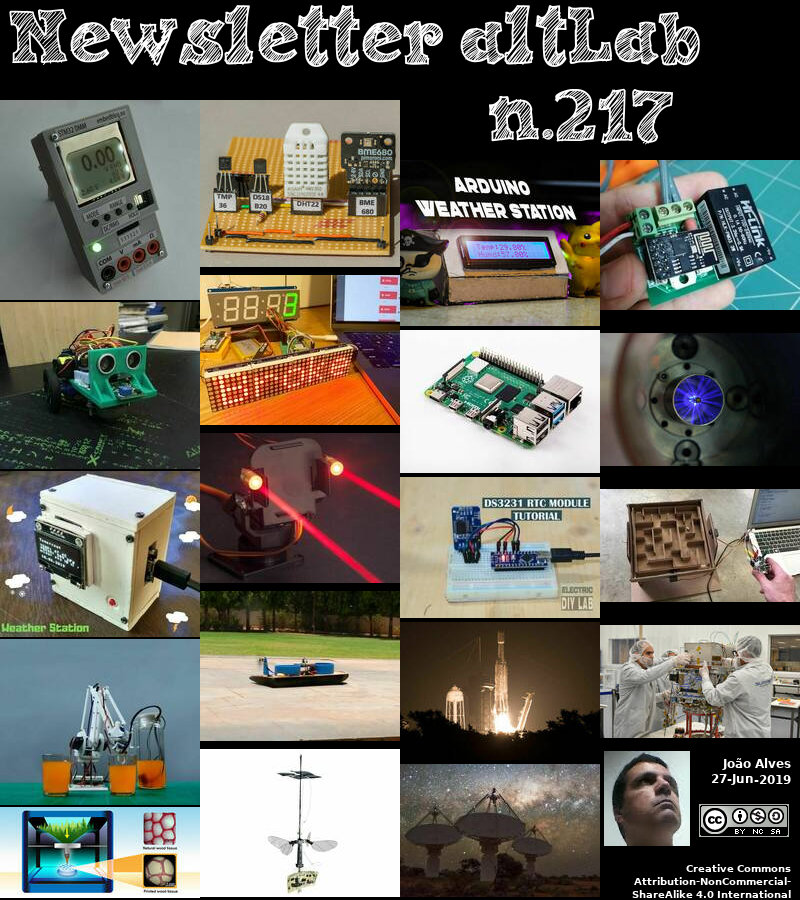2019-06-27 - Nº 217
Editorial
Esta é a Newsletter Nº 217 que se apresenta com o mesmo formato que as anteriores. Se gostar da Newsletter partilhe-a!
Todas as Newsletters encontram-se indexadas no link.
Esta Newsletter tem os seguintes tópicos:
Faz hoje anos que nascia, em 1806, Augustus De Morgan. Este matemático e lógico inglês fez um trabalho importante na lógica simbólica abstrata, a teoria das relações e formulou as leis de De Morgan: um é "NÃO (A E B) = (NÃO A) OU (NÃO B)" e o outro é "NÃO (A OU B) = (NÃO A) E (NÃO B)". Estas leis continuam a ser aplicadas na teoria da prova moderna e na programação de software. Quando ele definiu e introduziu o termo "indução matemática" (1838), ele deu ao processo uma base e clareza rigorosas que antes não tinham. Ele originou o uso da barra para representar fracções, como em 1/5 ou 3/7. Em Trigonometria e Álgebra Dupla (1849) ele deu uma interpretação geométrica de números complexos.
Por fim, faz hoje anos que nascia, em 1901, Merle Antony Tuve. Este Físico e geofísico norte-americano fez o primeiro uso de ondas de rádio pulsadas para explorar a ionosfera. Ele inventou o equipamento de detecção necessário para medir o tempo entre receber um pulso de rádio directo e um segundo pulso reflectido da ionosfera. As observações que ele fez forneceram a base teórica para o desenvolvimento do radar. Tuve, com Lawrence R. Hafstad e Norman P. Heydenburg, fizeram as primeiras e definitivas medições da força nuclear entre a força protão-protão nas distâncias nucleares. Durante a Segunda Guerra Mundial, ele desenvolveu o fusível de proximidade. Após a guerra, ele fez importantes contribuições para a sismologia experimental, a radioastronomia e a astronomia óptica.
Nesta semana que passou ficamos a conhecer a nova versão do Raspberry PI - 4. Continuando com o custo que nos habituou esta versão introduz um conjunto de novidades que passam pela existência de três versões da Board. De base todas elas equipadas com um micro-controlador ARM Cortex-A72 Quad-Core a 1.5GHz, uma interface Ethernet a Gigagit, wireless 802.11ac de banda dupla, Bluetooth 5.0, duas portas USB 3.0, duas portas USB 2.0, suporte micro-HDMI para duas saídas de vídeo até 4Kp60, GPI VideoCore VI. As três versões são de 1GB, 2GB ou 4GB de RAM. De notar que a disposição das interfaces foi alterada o que requer novas caixas. Também a alimentação passou a ser feita por USB-C para ultrapassar as limitações de potência que a interface micro-USB tinha permitindo o Raspberry PI 4 poder consumir mais.
Também esta semana ficámos a saber que no passado dia 25 a SpaceX lançou o STP-2 (Space Test Program-2). Este programa procedeu ao lançamento com sucesso de 24 satélites. Estes irão testar inúmeros factores que são necessários analisar em preparação para uma futura missão a Marte. Destes destacam-se os E-TBEx que irão explorar as bolhas nas camadas electricamente carregadas da atmosfera superior da Terra, que podem interromper as comunicações e os sinais GPS nos quais confiamos todos os dias, o "Deep Space Atomic Clock" que é um relógio atómico exclusivo que testará uma nova forma das naves espaciais navegarem no espaço profundo. A tecnologia pode tornar a navegação semelhante a um GPS possível na Lua e em Marte. O GPIM que testará um novo sistema de propulsão que funciona com um combustível não tóxico de alto desempenho de nave espacial. Esta tecnologia poderá ajudar a impulsionar constelações de pequenos satélites dentro e fora da órbita terrestre baixa. Ainda faz parte deste lançamento o DSX que a bordo transporta um instrumento projectado pelo JPL para medir vibrações de naves espaciais e quatro experiências da NASA que compõem os Testbeds de Ambiente Espacial (SET). A SET estudará como proteger melhor os satélites da radiação espacial, analisando o ambiente hostil do espaço próximo da Terra e testando várias estratégias para mitigar os impactos. Estas informações podem ser usadas para melhorar o projecto, a engenharia e as operações das naves, a fim de proteger as mesmas contra radiações nocivas causadas pelo Sol.
Na Newsletter desta semana apresentamos diversos projetos de maker assim como um modelo 3D que poderá ser útil. É apresentada a revista MagPI Nº83, o livro The Official Raspberry Pi Beginner’s Guide – 2nd Edition e a revista newelectronics de 11 de Junho.
 João Alves ([email protected])
João Alves ([email protected])
O conteúdo da Newsletter encontra-se sob a licença  Creative Commons Attribution-NonCommercial-ShareAlike 4.0 International License.
Creative Commons Attribution-NonCommercial-ShareAlike 4.0 International License.
Novidades da Semana
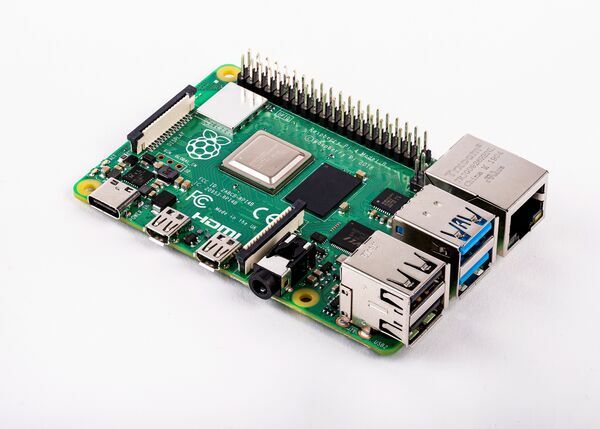
Raspberry Pi 4 on sale now from $35
"We have a surprise for you today: Raspberry Pi 4 is now on sale, starting at $35. This is a comprehensive upgrade, touching almost every element of the platform. For the first time we provide a PC-like level of performance for most users, while retaining the interfacing capabilities and hackability of the classic Raspberry Pi line. Get yours today from our Approved Resellers, or from the Raspberry Pi Store in Cambridge, open today 8am–8pm! Raspberry Pi 4 Model B Here are the highlights: - A 1.5GHz quad-core 64-bit ARM Cortex-A72 CPU (~3× performance) - 1GB, 2GB, or 4GB of LPDDR4 SDRAM - Full-throughput Gigabit Ethernet - Dual-band 802.11ac wireless networking - Bluetooth 5.0 - Two USB 3.0 and two USB 2.0 ports - Dual monitor support, at resolutions up to 4K - VideoCore VI graphics, supporting OpenGL ES 3.x - 4Kp60 hardware decode of HEVC video - Complete compatibility with earlier Raspberry Pi products" [...]
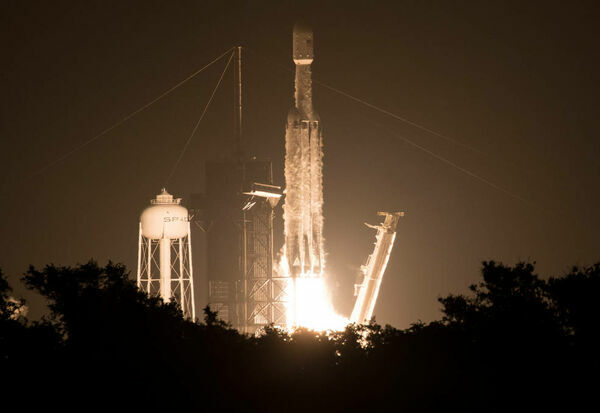
NASA Technology Missions Launch on SpaceX Falcon Heavy
"NASA technology demonstrations, which one day could help the agency get astronauts to Mars, and science missions, which will look at the space environment around Earth and how it affects us, have launched into space on a Falcon Heavy rocket. The NASA missions lifted off at 2:30 a.m. EDT Tuesday from NASA’s Kennedy Space Center in Florida, as part of the Department of Defense’s Space Test Program-2 (STP-2) launch. “This launch was a true partnership across government and industry, and it marked an incredible first for the U.S. Air Force Space and Missile Systems Center,” said Jim Reuter, associate administrator for NASA’s Space Technology Mission Directorate. “The NASA missions aboard the Falcon Heavy also benefited from strong collaborations with industry, academia and other government organizations.” The missions, each with a unique set of objectives, will aid in smarter spacecraft design and benefit the agency’s Moon to Mars exploration plans by providing greater insight into the effects of radiation in space and testing an atomic clock that could change how spacecraft navigate. With launch and deployments complete, the missions will start to power on, communicate with Earth and collect data. They each will operate for about a year, providing enough time to mature the technologies and collect valuable science data." [...]
Outras Notícias
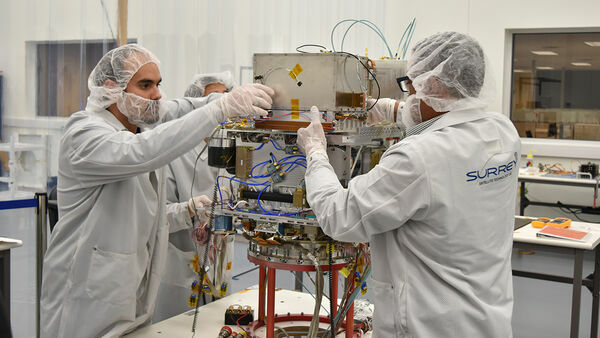
Five Things to Know about NASA's Deep Space Atomic Clock
"NASA is sending a new technology to space in late June that will change the way we navigate our spacecraft — even how we send astronauts to Mars and beyond. Built by NASA's Jet Propulsion Laboratory in Pasadena, California, the Deep Space Atomic Clock is a technology demonstration that will help spacecraft navigate autonomously through deep space. No larger than a toaster oven, the instrument will be tested in Earth orbit for one year, with the goal of being ready for future missions to other worlds. Here are five key facts to know about NASA's Deep Space Atomic Clock: It works a lot like GPS The Deep Space Atomic Clock is a sibling of the atomic clocks you interact with every day on your smart phone. Atomic clocks aboard satellites enable your phone's GPS application to get you from point A to point B by calculating where you are on Earth, based on the time it takes the signal to travel from the satellite to your phone. But spacecraft don't have GPS to help them find their way in deep space; instead, navigation teams rely on atomic clocks on Earth to determine location data." [...]
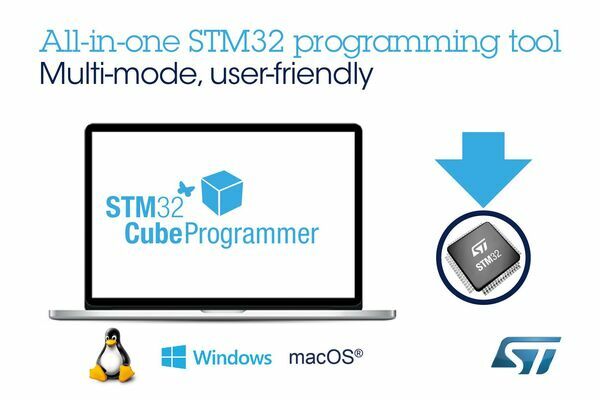
Latest Multi-OS Software Tool from STMicroelectronics Simplifies STM32 Programming and Protects Firmware Intellectual Property
"Making life easier for STM32* microcontroller (MCU) and microprocessor (MPU) users, and further strengthening the STM32Cube ecosystem, the latest version of the STM32CubeProgrammer from STMicroelectronics gathers the capabilities of multiple device programmers into just one universal tool. STM32CubeProgrammer lets users program their devices through any convenient connection, choosing from the MCU’s JTAG or single-wire debug (SWD) pins, a UART, or USB, SPI, I2C, or CAN interfaces. The new multi-OS software replaces several tools including ST Visual Programmer (STVP), DFuSe USB Device Firmware Upgrade programmer, Windows®-only STM32 Flash loader, and software utilities for use with ST-Link, to deliver maximum flexibility with the benefits of a consistent unified environment. From now on, new STM32 products will be supported only by STM32CubeProgrammer. Built-in features include the STM32 Trusted Package Creator, which protects OEMs’ intellectual property by encrypting firmware using an AES-GCM key and working with the STM32HSM-V1 companion Hardware Security Module (HSM). The HSM manages authentication and licensing, with counter-limited Secure Firmware Install (SFI) allowing OEMs to restrict the number of devices that can be programmed." [...]
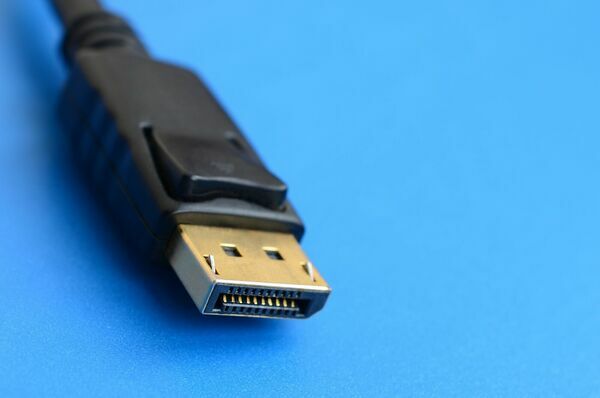
VESA Publishes DisplayPort 2.0 Video Standard Enabling Support For Beyond-8K Resolutions, Higher Refresh Rates For 4K/HDR And Virtual Reality Applications
"DisplayPort 2.0 enables up to 3X increase in video bandwidth performance (max payload of 77.37 Gbps); new built-in features enable improved user experience, greater flexibility and improved power efficiency SAN JOSE, Calif. – June 26, 2019 – The Video Electronics Standards Association (VESA®) today announced that it has released version 2.0 of the DisplayPort™ (DP) audio/video standard. DP 2.0 is the first major update to the DisplayPort standard since March 2016, and provides up to a 3X increase in data bandwidth performance compared to the previous version of DisplayPort (DP 1.4a), as well as new capabilities to address the future performance requirements of traditional displays. These include beyond 8K resolutions, higher refresh rates and high dynamic range (HDR) support at higher resolutions, improved support for multiple display configurations, as well as improved user experience with augmented/virtual reality (AR/VR) displays, including support for 4K-and-beyond VR resolutions. The advantages of DP 2.0 are enjoyed across both the native DP connector as well as the USB Type-C connector, which carries the DP audio/video signal through DisplayPort Alt Mode. DP 2.0 is backward compatible with previous versions of DisplayPort and incorporates all of the key features of DP 1.4a, including support for visually lossless Display Stream Compression (DSC) with Forward Error Correction (FEC), HDR metadata transport, and other advanced features. The increased video bandwidth performance of DP 2.0 carried over the USB-C connector enables simultaneous higher-speed USB data transfer without compromising display performance." [...]

Asteroid That's 3 Times As Long As a Football Field Will Whiz by Earth Thursday
"Summer is the season for tourists, and that includes a cosmic traveler — one that's three times the length of a football field — that's expected to visit Earth's neighborhood later this week. We're using the term "neighborhood" loosely here; the heavenly tourist (yes, it's an asteroid), known as 2008 KV2, is expected to zip by at a distance of about 4.2 million miles (6.7 million kilometers) from Earth on Thursday (June 27). But even though this visitor will be far away, the event's still notable; it's not every day that such a big space rock hurtles by our planet. To put 2008 KV2's distance from Earth into perspective, the moon is about 238,900 miles (384,400 km) away from us, and the asteroid will be more than 17 times that distance. Scientists discovered the asteroid in 2008 and promptly set about calculating how often it came within Earth's vicinity; the researchers produced estimates of its travels between 1900 and 2199. It turns out, 2008 KV2 is a fairly frequent visitor." [...]
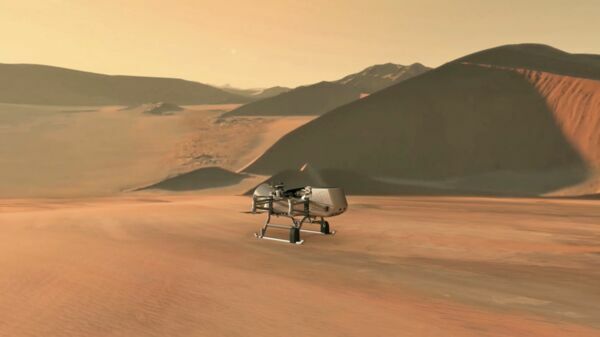
NASA's Dragonfly Will Fly Around Titan Looking for Origins, Signs of Life
"NASA has announced that our next destination in the solar system is the unique, richly organic world Titan. Advancing our search for the building blocks of life, the Dragonfly mission will fly multiple sorties to sample and examine sites around Saturn’s icy moon. Dragonfly will launch in 2026 and arrive in 2034. The rotorcraft will fly to dozens of promising locations on Titan looking for prebiotic chemical processes common on both Titan and Earth. Dragonfly marks the first time NASA will fly a multi-rotor vehicle for science on another planet; it has eight rotors and flies like a large drone. It will take advantage of Titan’s dense atmosphere – four times denser than Earth’s – to become the first vehicle ever to fly its entire science payload to new places for repeatable and targeted access to surface materials." [...]

Mystery radio waves from space tracked to a surprising home galaxy
"We have tracked a strange blast of cosmic radio waves back to its home galaxy. This is the second time such a trace has been possible, but the differences from the first one may require us to rethink our ideas of what causes these so-called fast radio bursts (FRBs). For just 1.3 milliseconds on 24 September, 2018, a barrage of radio waves arrived from space. It was pure luck that all 36 of the antennae that make up the Australian Square Kilometre Array Pathfinder (ASKAP) were pointed in the same direction, towards the area in the sky where the FRB flashed. That allowed researchers to combine data from all of the antennae and calculate where in the universe it came from – around 13,000 light years from the centre of its home galaxy, which is 4 billion light years away from us. “This is a magnificent technical achievement,” says Shami Chatterjee at Cornell University in New York." [...]
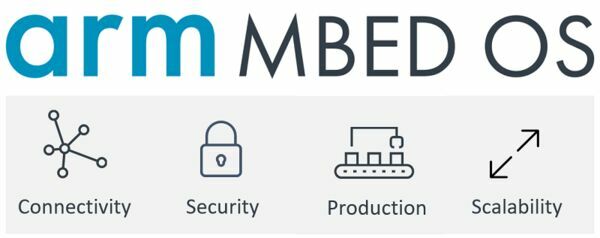
Arm Mbed OS 5.13 released
"As IoT devices proliferate, our focus is shifting toward optimizing Arm Mbed OS to best address the use cases our customers face. In 5.13, we have reduced the number of new features we’re delivering and have instead concentrated on specific optimizations of existing features that benefit our customers. As with our 5.12 release, the new features we’ve released are primarily concentrated on security, which remains the key challenge in IoT product development, and connectivity. Separation of Mbed TLS and Mbed Crypto As our security services in Mbed OS have evolved to meet the requirements of Arm’s Platform Security Architecture (PSA), we have separated the cryptographic capabilities from the network security components of Mbed TLS into two distinct libraries: Mbed TLS remains the cornerstone of embedded network security, and Mbed Crypto delivers support for crypto hardware under the PSA Crypto APIs. This provides a clear way to use cryptography to secure data while the device both communicates and stores it. With the new APIs, you can also abstract how cryptographic functions are provided: through hardware acceleration, a software-only implementation or through a separate secure execution environment provided by either a secure element, a dual core v7-M platform or a v8-M platform with TrustZone." [...]
Ciência e Tecnologia
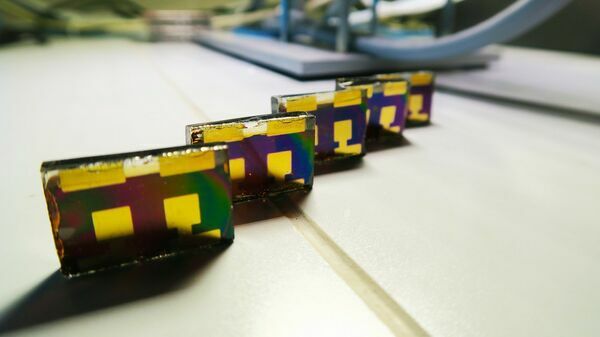
Perovskite solar cells tested for real-world performance – in the lab
"Researchers at EPFL bring diurnal and seasonal variations into the lab to test the performance of perovskite solar cells under realistic conditions. The findings are published in Nature Energy. It was only ten years ago that metal-halide perovskites were discovered to be photovoltaic materials. Today, perovskite solar cells made are almost as efficient as the best conventional silicon ones, and there is much hope that they will become a highly efficient and low-cost alternative, as they can be manufactured by rather simple and fast methods like printing. The major obstacle for commercialization is the stability of perovskite devices. Operational stability is commonly assessed either by continuous illumination in the lab or by outdoor testing." [...]
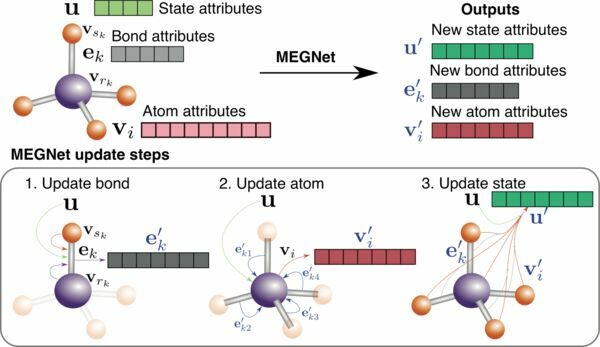
Engineers Use Graph Networks to Accurately Predict Properties of Molecules and Crystals
"Nanoengineers at the University of California San Diego have developed new deep learning models that can accurately predict the properties of molecules and crystals. By enabling almost instantaneous property predictions, these deep learning models provide researchers the means to rapidly scan the nearly-infinite universe of compounds to discover potentially transformative materials for various technological applications, such as high-energy-density Li-ion batteries, warm-white LEDs, and better photovoltaics. To construct their models, a team led by nanoengineering professor Shyue Ping Ong at the UC San Diego Jacobs School of Engineering used a new deep learning framework called graph networks, developed by Google DeepMind, the brains behind AlphaGo and AlphaZero. Graph networks have the potential to expand the capabilities of existing AI technology to perform complicated learning and reasoning tasks with limited experience and knowledge—something that humans are good at. For materials scientists like Ong, graph networks offer a natural way to represent bonding relationships between atoms in a molecule or crystal and enable computers to learn how these relationships relate to their chemical and physical properties. The new graph network-based models, which Ong’s team dubbed MatErials Graph Network (MEGNet) models, outperformed the state of the art in predicting 11 out of 13 properties for the 133,000 molecules in the QM9 data set." [...]
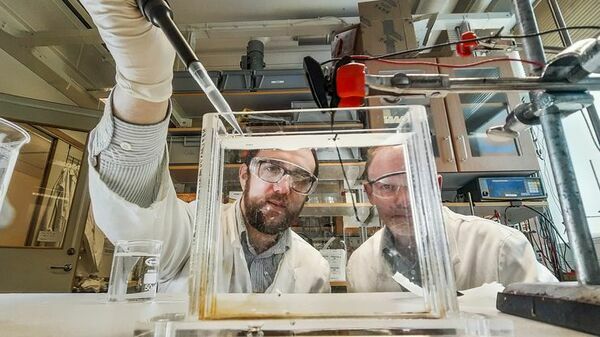
Artificial muscles powered by glucose
"Artificial muscles made from polymers can now be powered by energy from glucose and oxygen, just like biological muscles. This advance may be a step on the way to implantable artificial muscles or autonomous microrobots powered by biomolecules in their surroundings. The motion of our muscles is powered by energy that is released when glucose and oxygen take part in biochemical reactions. In a similar way, manufactured actuators can convert energy to motion, but the energy in this case comes from other sources, such as electricity. Scientists at Linköping University wanted to develop artificial muscles that act more like biological muscles. They have now, in a study published in the prestigious journal Advanced Materials, demonstrated the principle using artificial muscles powered by the same glucose and oxygen as our bodies use." [...]

Making systems robust
"Both nature and technology rely on integral feedback mechanisms to ensure that systems resist external perturbations. ETH researchers have now used synthetic biology to design a new mechanism of this sort from scratch. For the first time, they have introduced it into a living cell as an artificial genetic regulatory network. This will be a useful tool for cell therapy in medicine and for biotechnology. The human body ensures that the calcium concentration in the blood remains constant. In the same way, an aircraft’s autopilot keeps the plane flying at a constant altitude." [...]
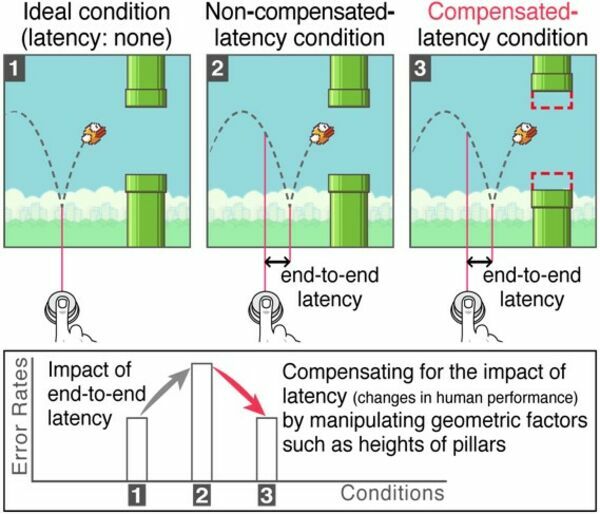
Play Games With No Latency
"One of the most challenging issues for game players looks to be resolved soon with the introduction of a zero-latency gaming environment. A KAIST team developed a technology that helps game players maintain zero-latency performance. The new technology transforms the shapes of game design according to the amount of latency. Latency in human-computer interactions is often caused by various factors related to the environment and performance of the devices, networks, and data processing. The term ‘lag’ is used to refer to any latency during gaming which impacts the user’s performance. Professor Byungjoo Lee at the Graduate School of Culture Technology in collaboration with Aalto University in Finland presented a mathematical model for predicting players’ behavior by understanding the effects of latency on players." [...]
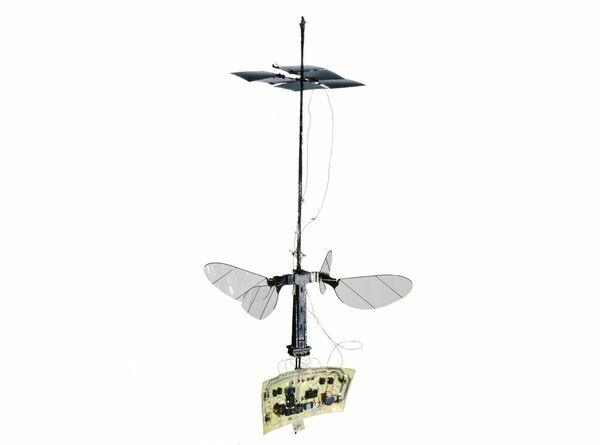
The RoboBee flies solo
"In the Harvard Microrobotics Lab, on a late afternoon in August, decades of research culminated in a moment of stress as the tiny, groundbreaking RoboBee made its first solo flight. Graduate student Elizabeth Farrell Helbling, PhD ’19, and postdoctoral fellow Noah T. Jafferis from the Harvard John A. Paulson School of Engineering and Applied Sciences (SEAS), the Graduate School of Arts and Sciences and The Wyss Institute for Biologically Inspired Engineering caught the moment on camera. Helbling, who has worked on the project for six years, counted down. “Three, two, one, go.” The bright halogens switched on and the solar-powered RoboBee launched into the air. For a terrifying second, the tiny robot, still without on-board steering and control, careened towards the lights. Off camera, Helbling exclaimed and cut the power." [...]

Scientists use atoms to simulate quantum physics in curved spacetimes
"UChicago team glimpses phenomena that underlie black holes, other extreme physics Black holes fascinate the public and scientists alike because they are where it all breaks down: matter, unlucky stars and space flotsam, and our understanding of physics. And while scientists have chipped away at their mysteries—from capturing the first image of one, to detecting the ripples in space-time they create when colliding—key parts of understanding black holes have escaped them. For example, Stephen Hawking suggested in 1974 that black holes actually emit a stream of warm radiation created by their extremely strong gravity; but of course, no one has been able to get close enough to a black hole to observe it. Physicist William Unruh later suggested that the same type of radiation would appear if you were moving at a high enough acceleration; Einstein’s theory of general relativity confirms the equivalence between the two types of radiation. But Unruh radiation also has not been observed, since you would need to be accelerating tremendously fast just to see a tiny bit of the radiation—a G force on the order of a billion billion. (Fighter pilots top out at 10 Gs)." [...]
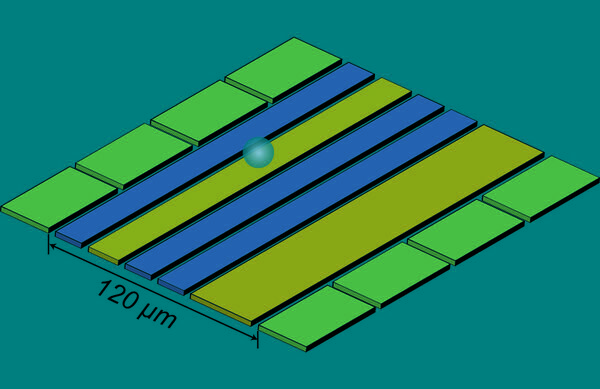
NIST Team Supersizes ‘Quantum Squeezing’ to Measure Ultrasmall Motion
"Physicists at the National Institute of Standards and Technology (NIST) have harnessed the phenomenon of “quantum squeezing” to amplify and measure trillionths-of-a-meter motions of a lone trapped magnesium ion (electrically charged atom). Described in the June 21 issue of Science, NIST’s rapid, reversible squeezing method could enhance sensing of extremely weak electric fields in surface science applications, for example, or detect absorption of very slight amounts of light in devices such as atomic clocks. The technique could also speed up operations in a quantum computer. “By using squeezing, we can measure with greater sensitivity than could be achieved without quantum effects,” lead author Shaun Burd said. “We demonstrate one of the highest levels of quantum squeezing ever reported and use it to amplify small mechanical motions,” NIST physicist Daniel Slichter said. “We are 7.3 times more sensitive to these motions than would be possible without the use of this technique.” Although squeezing an orange might make a juicy mess, quantum squeezing is a very precise process, which moves measurement uncertainty from one place to another." [...]
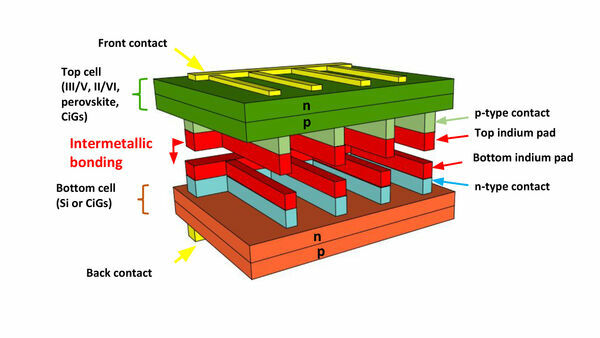
Researchers Create Multi-Junction Solar Cells from Off-the-Shelf Components
"Multi-junction solar cells are both the most efficient type of solar cell on the market today and the most expensive type of solar cell to produce. In a proof-of-concept paper, researchers from North Carolina State University detail a new approach for creating multi-junction solar cells using off-the-shelf components, resulting in lower cost, high-efficiency solar cells for use in multiple applications. Multi-junction, or stacked, solar cells are currently the most efficient cells on the market, converting up to 45% of the solar energy they absorb into electricity. The cells are constructed by stacking semiconductors with varying bandgaps on top of one another, thereby allowing the cell to absorb differing wavelengths of solar radiation. However, these cells are much more expensive to produce than less efficient thin solar films. “We want to create high efficiency solar cells at a reasonable cost,” says Salah Bedair, Distinguished Professor of Electrical and Computer Engineering at NC State and lead author of the research." [...]

Branching out: Making graphene from gum trees
"Researchers have developed a cost-effective and eco-friendly way of producing graphene using one of Australia’s most abundant resources, eucalyptus trees. Graphene is the thinnest and strongest material known to humans. It’s also flexible, transparent and conducts heat and electricity 10 times better than copper, making it ideal for anything from flexible nanoelectronics to better fuel cells. The new approach by researchers from RMIT University (Australia) and the National Institute of Technology, Warangal (India), uses Eucalyptus bark extract and is cheaper and more sustainable than current synthesis methods. RMIT lead researcher, Distinguished Professor Suresh Bhargava, said the new method could reduce the cost of production from $USD100 per gram to a staggering $USD0.5 per gram. “Eucalyptus bark extract has never been used to synthesise graphene sheets before and we are thrilled to find that it not only works, it’s in fact a superior method, both in terms of safety and overall cost,” said Bhargava." [...]
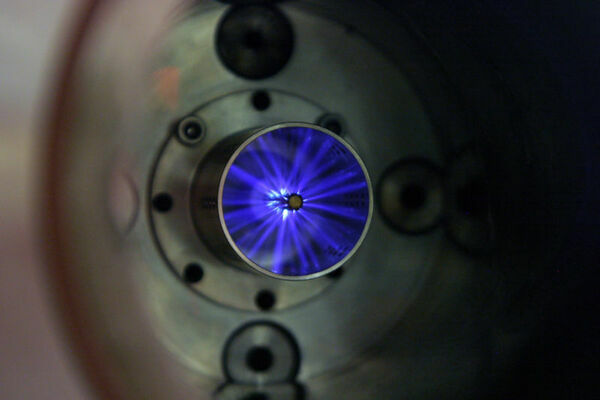
Swapping spark plugs for nanopulses could boost engine efficiency by 20%
"Here in 2019, only the most fringe reactionaries are able to claim with a straight face that climate change is not a thing. But after years of the media doing its "two sides" thing, recalcitrant policy makers dragging their heels, a continued lack of investment in public transport, and intense, well-funded opposition from vested interests like the oil industry, there has been a heavy cost on attempts to decarbonize. When it comes to the transportation sector, even with the best will in the world, it will be decades before we see the end of the internal combustion engine. So when a new technology comes along that offers a really meaningful improvement in fuel efficiency when fitted to existing engines, my interest gets piqued. Such is the case with a new ignition system from a company called Transient Plasma Systems. The company has its roots in pulsed power technology developed for the Department of Defense at the University of Southern California, specifically nanosecond-duration pulses of power." [...]
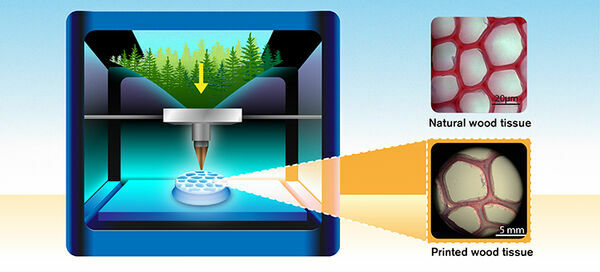
Mimicking wood’s ultrastructure with 3D printing
"Researchers at Chalmers University of Technology, Sweden, have succeeded in 3D printing with a wood-based ink in a way that mimics the unique ‘ultrastructure’ of wood. Their research could revolutionise the manufacturing of green products. Through emulating the natural cellular architecture of wood, they now present the ability to create green products derived from trees, with unique properties – everything from clothes, packaging, and furniture to healthcare and personal care products. The way in which wood grows is controlled by its genetic code, which gives it unique properties in terms of porosity, toughness and torsional strength. But wood has limitations when it comes to processing. Unlike metals and plastics, it cannot be melted and easily reshaped, and instead must be sawn, planed or curved." [...]
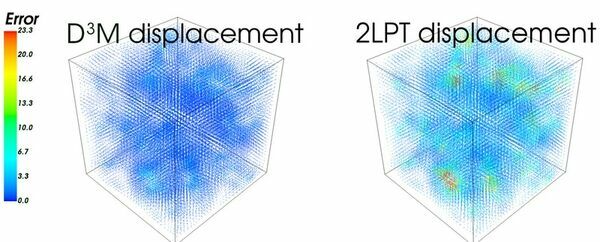
The First AI Simulation of the Universe Is Fast and Accurate — and Even Its Creators Don’t Know How It Works
"The new model can envision universes with unique parameters, such as extra dark matter, even without receiving training data in which those parameters varied. For the first time, astrophysicists have used artificial intelligence techniques to generate complex 3D simulations of the universe. The results are so fast, accurate and robust that even the creators aren’t sure how it all works. “We can run these simulations in a few milliseconds, while other ‘fast’ simulations take a couple of minutes,” says study co-author Shirley Ho, a group leader at the Flatiron Institute’s Center for Computational Astrophysics in New York City and an adjunct professor at Carnegie Mellon University. “Not only that, but we’re much more accurate.” The speed and accuracy of the project, called the Deep Density Displacement Model, or D3M for short, wasn’t the biggest surprise to the researchers. The real shock was that D3M could accurately simulate how the universe would look if certain parameters were tweaked — such as how much of the cosmos is dark matter — even though the model had never received any training data where those parameters varied." [...]
Modelos 3D
Com a disponibilidade de ferramentas que permitem dar azo a nossa imaginação na criação de peças 3D e espaços como o thingiverse para as publicar, esta rubrica apresenta alguns modelos selecionados que poderão ser úteis.

Simple Fastener: Practical Intro to 3D Modeling
"Put simply this is a reusable fastener that can be used as a bread tie, chip bag tie, cable organizer, etc. This idea evolved from an earlier project where I created a minimal key fastener. The shape is a very simple slot shape with two small whole punched out where the rubber filament goes through. In less than an hour of 3D modeling and printing, you will have yourself a simple practical 3D print! I will show two 3D modeling softwares (Fusion 360 and TinkerCAD), either of which can be used to create the fastener along with the assembly process. When my school got a 3D printer I was tempted to print a bunch of stuff I found online, but found that 3D modeling something myself was a lot more satisfying." [...]
Documentação
A documentação é parte essencial do processo de aprendizagem e a Internet além de artigos interessantes de explorar também tem alguma documentação em formato PDF interessante de ler. Todos os links aqui apresentados são para conteúdo disponibilizado livremente pelo editor do livro.
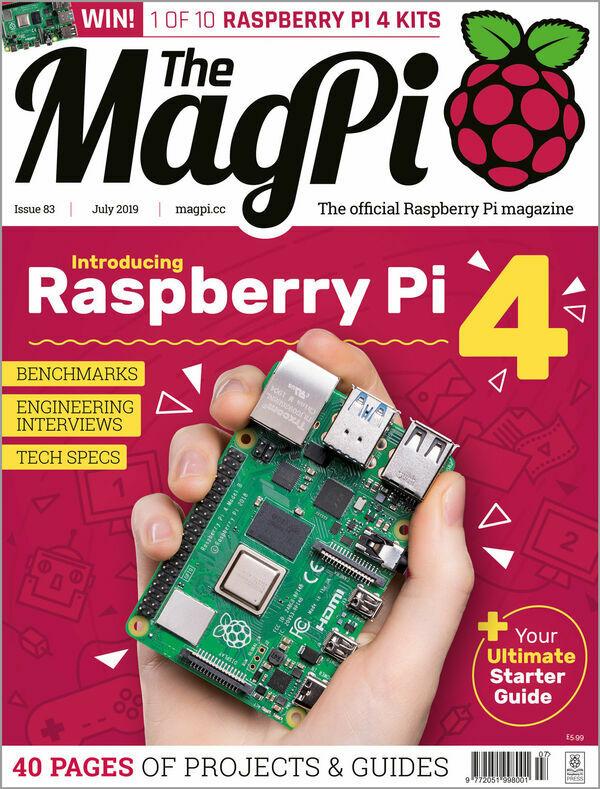
The MagPI 83
"Introducing Raspberry Pi 4. With up to 4GB RAM, a faster 1.5GHz ARM CPU, dual 4K HDMI support, faster USB 3.0 connections, and Gigabit Ethernet, Raspberry Pi 4 is a generational leap forward. In this extra-special edition of The MagPi, we have a huge 12-page feature examining every aspect of Raspberry Pi 4. Benchmark tests show a vast increase in performance, all thanks those improved specs (which we cover in-depth). We’ve also got an interview with Eben Upton on the making of Raspberry Pi 4, plus Simon Long talks about Raspbian ‘Buster’, the all-new version of the OS that powers Raspberry Pi. Plus!" [...]
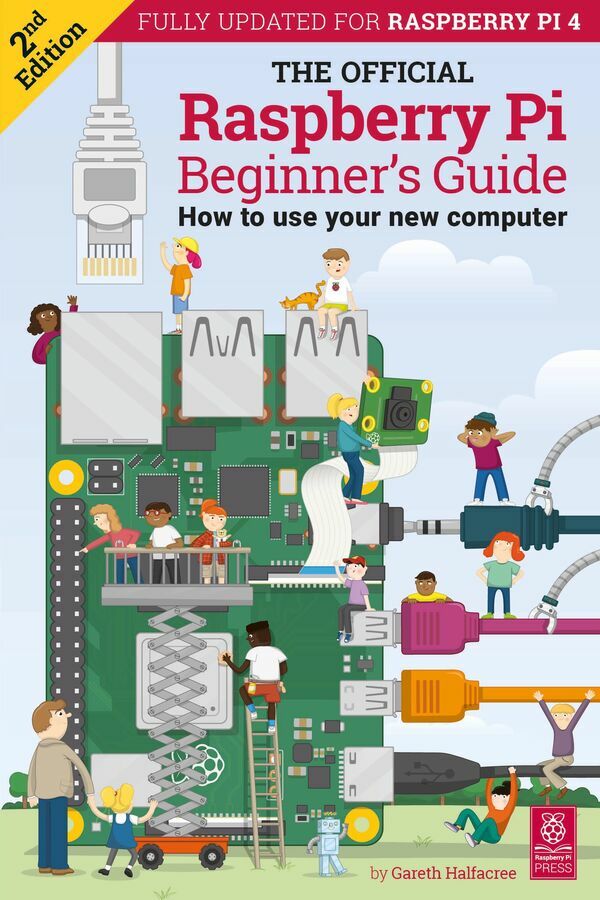
The Official Raspberry Pi Beginner’s Guide – 2nd Edition
"Fully updated for the Raspberry Pi 4 and latest software, this 244-page official Raspberry Pi book is crammed with projects and beginner’s guides containing all the information you need to get started using your new computer! Learn how to set up the Raspberry Pi, install an operating system, and start using it. Follow step-by-step guides to code your own animations and games, using both the Scratch and Python languages. Create amazing projects by connecting electronic components to the Pi’s GPIO pins. Plus much, much more! 252 pages of essential information: Set up your Raspberry Pi for the first time Learn to code using Scratch and Python Control electronics: LEDs, buttons, and sensors Add a camera to shoot photos and videos Creating awe-inspiring projects Specifically designed for beginners" [...]

newelectronics 11 Junho 2019
"New Electronics is a fortnightly magazine focusing on technological innovation, news and the latest developments in the electronics sector. Downloadable as a digital page turner or pdf file, or offered as a hard copy, the New Electronics magazine is available in a format to suit you. " [...]
Projetos Maker
Diversos Projetos interessantes.

Build a Mini DIY Hydroponic Systems & DIY Hydroponic Herb Garden With WiFi Alerts
"In this tutorial we will show you how to build a #DIY #hydroponics system. This DIY hydroponic system will water on a custom hydroponic watering cycle with 2 minutes on and 4 minutes off. It will also monitor the reservoir water level. This system will be connected to WiFi so it can send notification alerts whenever the water reservoir is running low on water and needs to be refilled. Supplies:1/4" outer diameter landscaping tubing 7 gallon storage bin with a lid2" net potsfiber mediumclay pellets2" hole saw bitlandscaping tubingtee connectors zip tieswater nozzles Adosia Automatic Plant Feeder Reservoir subassembly kit: 1 Adosia IoT device1 12V water pump / level switch assembly (detect empty water / protect pumps)1 extra 12V submersible water pump for dual pump operation1 ruggedized analog soil moisture sensor1 horizontal water level switch (detect low water level)1 DC power supply (12V/1A)" [...]
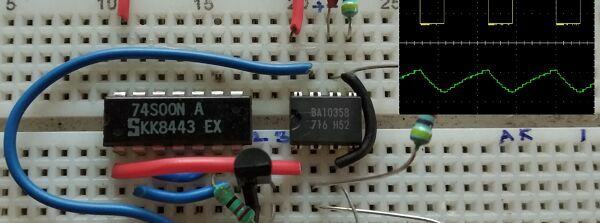
Building your own 555 Timer IC
"The 555 Timer IC is one of those evergreen and versatile ICs that finds place in every common place electronics applications. What does it do? It generates a square wave used in timing applications and many other fields. It mainly has three modes of operation – monostable, abstable , bistable. Each of these modes can be implemented by using very few additional components. Here, I will show how you can make your own version of the 555 timer using just NAND gates, opamps , a transistor and a few resistors!" [...]
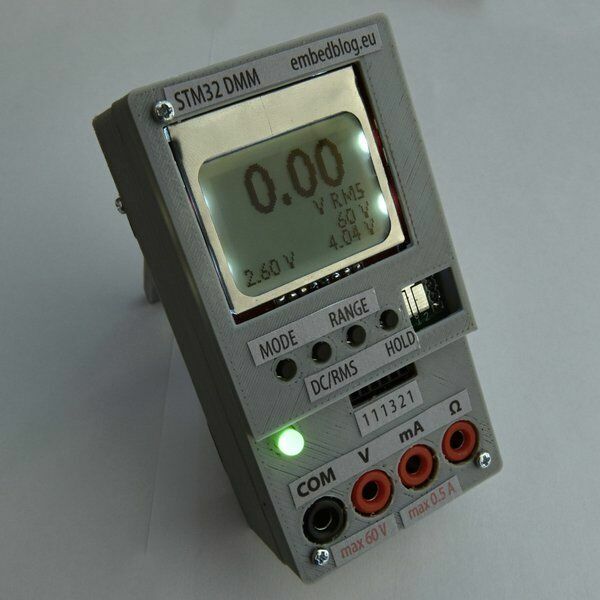
STM32 Open Source Multimeter
"A multimeter, based on the STM32F103, which can measure voltage, current and power, both bipolar and in DC and true RMS. In short, I needed more multimeters at my lab. You can get these cheap Chinese "multimeters" from Ebay, but I don't trust them at all and they lack some of the features I want (PC connectivity, RMS, power measurement, electronic range switch, capacity measurement, ...). So I wondered, what can I achieve with circa 10 dollars worth of parts?Well, turns out the STM32F1 is pretty powerful and I managed to cram all of the above functions into this little thing! And as a little bonus, it pretty accurate (for a day-to-day prototyping at least, it's not a 200 dollar Fluke). DETAILS Version 1.2B released So, after a few revisions I decided to publish this project." [...]
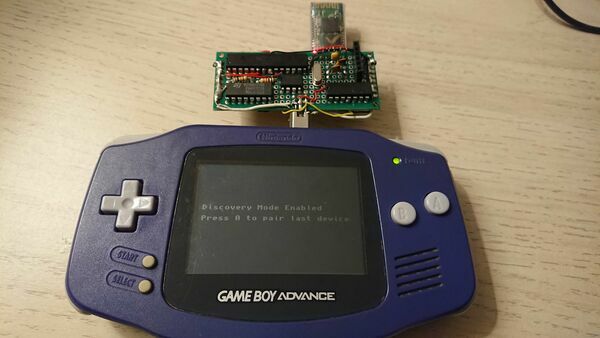
GBA Bluetooth HID
"Turn your Game Boy Advance into a Bluetooth Controller :) How to use it: After launching the rom the bluetooth module enters discoverable mode. This means you can pair to it from whatever device you are going to use it with (PC, phone, Android TV...). After pairing the program will start sending keys to the device. The device address is stored so next time you launch you just have to press A to automatically connect to that device. How it works: The gba contains the code for a GBA program that uses the link port to communicate with a HC-05 bluetooth module using UART (HC-05 flashed with RN-42 firmware, find how to do it in the links at the bottom). This rom is stored in a W25Q32 flash chip." [...]
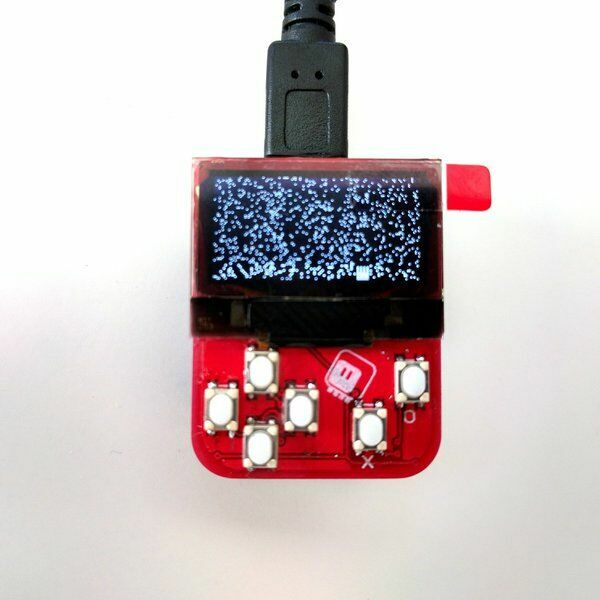
D1 Mini UI Shield
"Add a user interface to a D1 mini Add a user interface to a D1 mini DETAILS Often you need some kind of a user interface for your project — a display, a menu, maybe some icons, some numbers or some plot, etc. Sure, you can simply slap a display module on it, but then you still need some kind of input. If your display comes with a touchscreen and you are ready to handle the complexity in code, then great. Otherwise you need to add a bunch of buttons, a joystick, an encoder or some other way of selecting options. And since at that point you have ran out of GPIO pins on your D1 Mini, you also need some kind of GPIO expander. And then you have to put it in some box to attach the buttons to, and it all gets complicated quickly." [...]
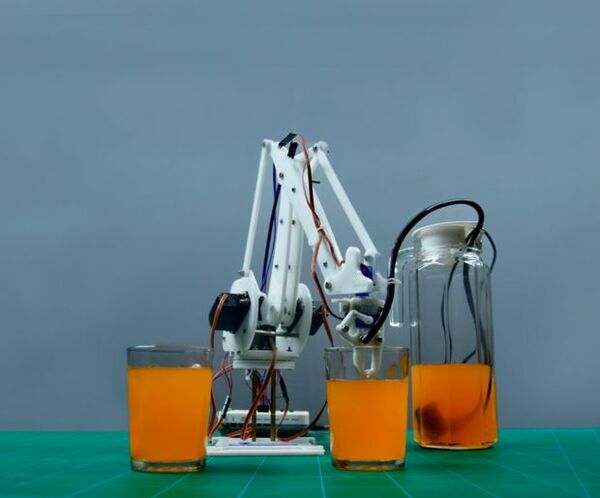
Automatic Robotic Arm Bartender Using Evive- Arduino Based Embedded Platform
"Raise your hands if you love parties! But what if youre the host? Lets be honest, as much as we love having people over, taking care that everything is timely served and people have a great time is kind of a big deal. Though we may not be able to help you with most of the things, we can with one; or at least this project can! Come in the robotic arm bartender, your personal drinks serving robot! Just follow the instructions given to make and code it with PictoBlox- an advanced graphical programming software." [...]
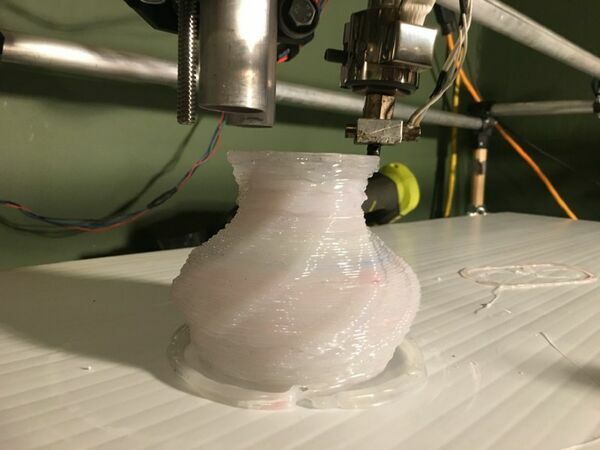
Trash Printer - Recycled Plastic 3D Print Head
"This is a design for a low-cost extruder for printing objects directly from recycled plastic flakes, instead of using filament. In the fall of 2016, I built a 'Precious Plastic' open source plastic shredder, and started experimenting with what I could make with shredded waste plastic. I built the Precious Plastic extruder, but was frustrated at how difficult and time consuming it was to create anything actually functional or useful. So I began to modify the Precious Plastic design, putting it on a vertical axis and trying to make it light enough to fit on a CNC router gantry, and power it with a stepper motor so that it could be controlled using existing 3D printing software. After many iterations, I finally got it printing this Spring, and the results have been very promising! It can currently print low-resolution objects with a build area of 24" x 12" x 4", but those dimensions are limitations of my gantry, not the extruder itself." [...]
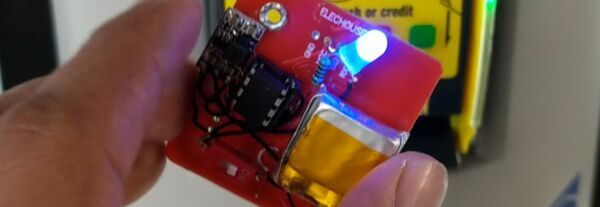
NFCopy85
"NFCopy85 is a 10 dollars device to make replay attacks against NFC payment systems. Tested it against Samsung Pay, Google Pay and Wells Fargo Wallet NFC tokens in US. Hardware NFCopy85 is a small version of NFCopy. This tiny version is a combination of ATtiny85 and a small PN532 board. Adding a 3.7 LiPo battery and a power booster to increase the 3.7V to 5V for the PN532 board. Also I added a LED with a resistor just for debugging and to show activity." [...]
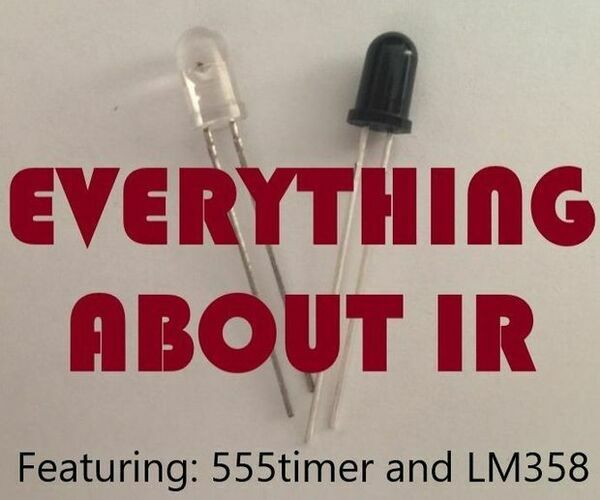
Intro to IR Circuits
"IR is a complex piece of technology yet very simple to work with. Unlike LEDs or LASERs, Infrared cannot be seen with the human eye. In this Instructable, I will demonstrate the use of Infrared through 3 different circuits. The circuits will not be using IR receivers and microcontrollers, instead, they will use a photodiode to because it is more simple. " [...]
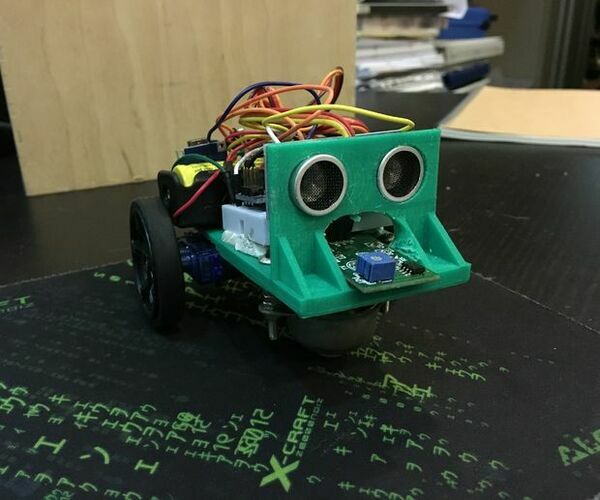
Mini-Sumo Bot
"What Is A Sumo Bot? This project was inspired by the competition style of sumo robotics of which an example can be found here. Two bots are placed in a black ring with a white border with the objective being to autonomously knock the other bot out of the ring. This is why it makes a good project when it comes to the use of sensors. In this instructable, I will guide you on how to create a mini sumo bot of your own. It is a great project to pass some time or to even start a robotics event of your own." [...]
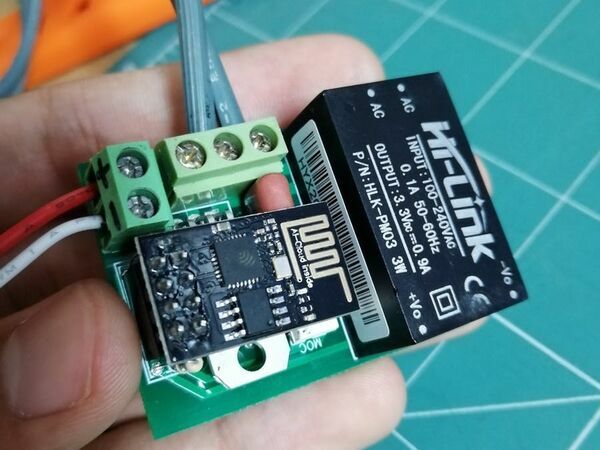
WiFi Switch for Home Appliances With ESP8266
"Learn how the build your own WiFi switch with the ESP module and how to control any appliance of your favorite place. What are WiFi Switches? Nowadays we are living in an Internet of Things age and WiFi Switches are basically the foundation of it. They are devices that can turn on, off or dim home appliances like lights, fans, etc remotely or autonomously, controlled by our cellphones, our voice, the room temperature or even weather reports. How do they work? They are based on wireless communication (commonly known as WiFi) that let them connect to the internet and process data, so they can take action due to certain conditions established by the user." [...]
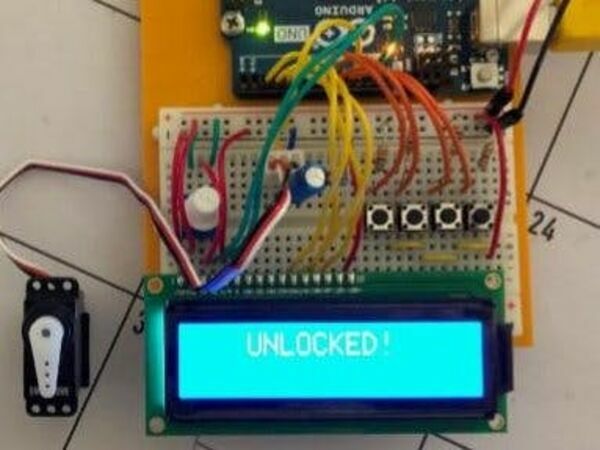
Arduino Lock Box
"A quick build for an Arduino Uno that uses a countdown timer to open a servo motor gate in order to use it as a lock. So, Why Build This? This invention is deigned to be a “lock box” with a timer. Once the timer has counted down to zero it sends a signal to rotate the servo motor 90 degrees to unlock the hatch on the box it is installed in. There are four push buttons, if you hold the first to the left, it will bring you into settings. Here you can use the second button from the left to toggle between hours, minutes, and seconds." [...]
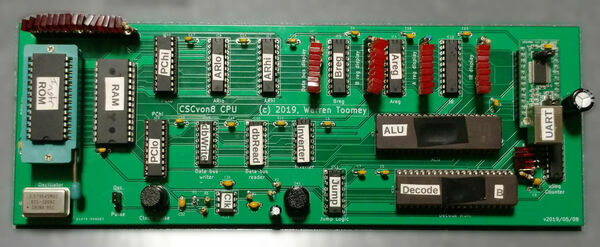
CSCvon8: 8-bit von Neumann Crazy Small CPU
"This repository holds the files for my 8-bit "big brother" CPU to the 4-bit Crazy Small CPU. This is a von Neumann style CPU designed with 7400-style logic chips and some RAM and ROM. The CPU requires only seventeen chips, not including the clock circuitry. The overall design of the CPU is covered in Docs/CSCvon8_design.md. Also read the getting started guide and the guide to building the PCB version. As at the 18th May 2019 I have the CPU running solidly at 3.57MHz on the PCBs that I ordered from the PCB design in the Schematics folder." [...]
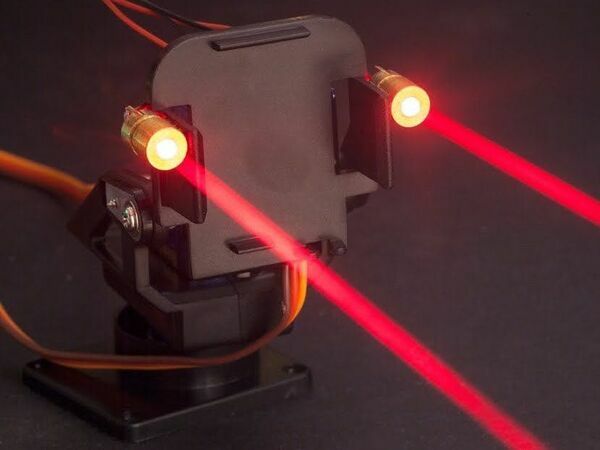
How to Make a Laser Turret for Your Cat
"Story Servos of this turret are controled by the joystick : Y axis of the joystick controls the horizontal sweep X axis of the joystick controls the vertical sweep" [...]
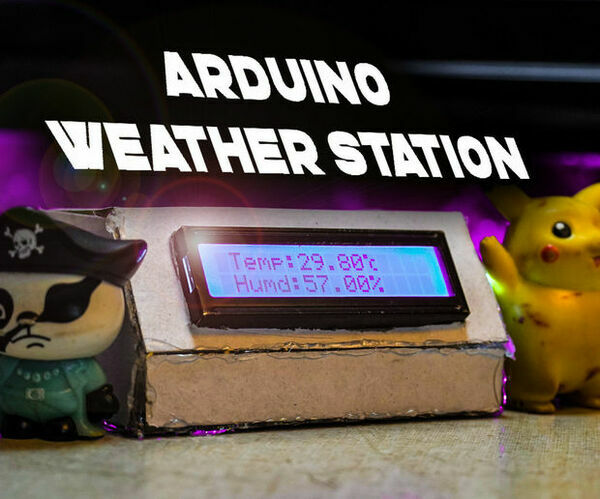
How to Make an Arduino Weather Station With DHT11 Temperature and Humidity Sensor
"Recently I started playing around with DHT11 Temperature and Humidity sensor, at that time around, I had an idea to make a small yet effective Weather Station, so in this project inscructable, we will use the DHT11 sensor from the previous tutorial and turn it into mini weather station for our desk, so follow up this tutorial to build this awesome Weather Station for yourself! Supplies: DHT 11 Sensor 16X2 I2C LCD Display Arduino Nano 3D Printed Parts ( attached in further Steps ) PCB board / Bread Board ( files attached in further steps ) (OPTIONAL) Cardboard (OPTIONAL) Hotglue Gun (OPTIONAL) Scissor/ Cutter" [...]
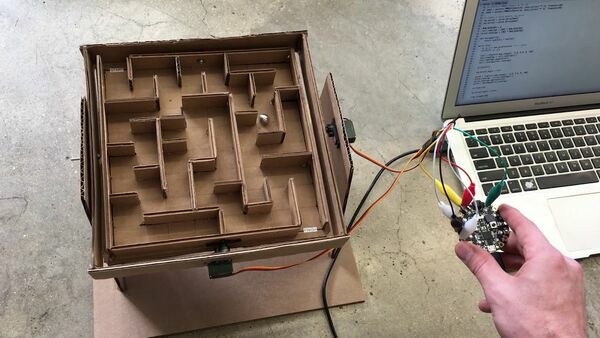
Tilt Controlled Marble Maze
"This project uses the accelerometer on the Circuit Playground Express board to control the X and Y axes of a maze. The user can guide a marble through the maze by simply tilting the Circuit Playground Express. This project is constructed using only cardboard, hot glue, and a couple of screws. " [...]
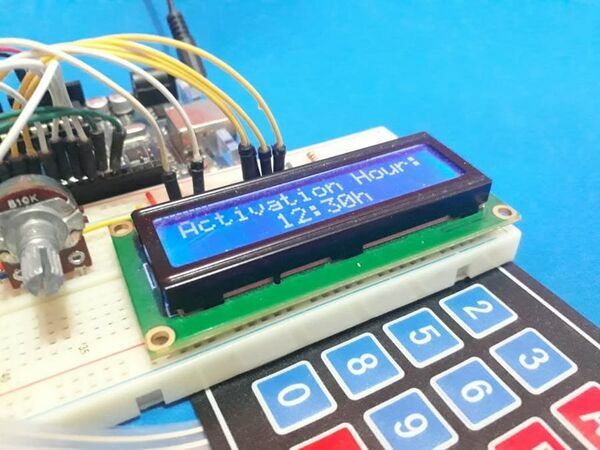
Programmable Timer for Activation of Devices - Part II
"In this the second part you'll learn how to implement the timer and function to program the hour to activate the device. Introduction In the first part of this article, we presenting how to create all process to implement this project. You can access the first part in the link (Access the first part of the Article) Now, through this second part, we'll present all process to create the functions to program the clock and date and program the hour of device activation. Therefore, through this functions, we'll can learn several principles of application and uses of Real Time Clock (RTC) DS1307. Proposed Functions for the Project According to explain in part I, the project has an aim to activate and deactivate the device in a programmed hour by the user. Therefore, based in the problematic, is need use the CHIP Real Time Clock." [...]
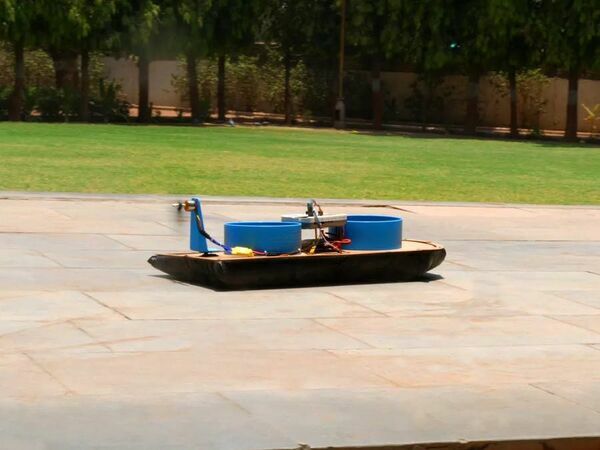
Smartphone Conrolled Hovercraft Made Using Evive-Arduino
"This project will show you how to make your own DIY hovercraft. Story We’ve made a Smartphone-controlled electric boat and we’ve made a chuck glider. In this project, we’re going to make something that can both float and fly! You guessed it; we’re going to show you how to make your own DIY hovercraft at your home all by yourself. We’re to program it using PictoBlox, our graphical programming software with advanced capabilities so that we can control it using Dabble, our ingeniously developed project interaction and controller app. ;) Download PictoBlox from HERE and get Dabble on Google Play." [...]
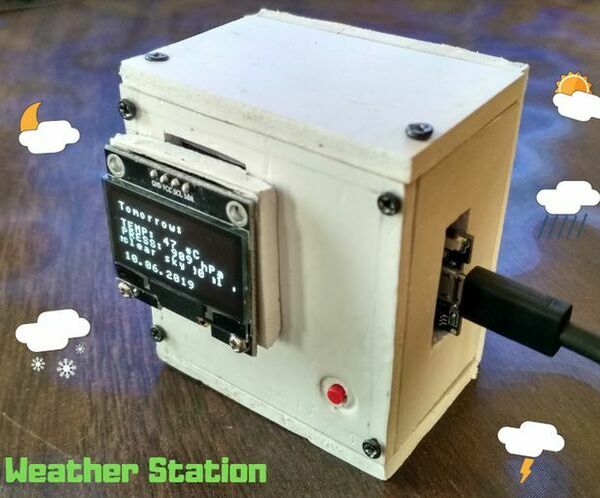
Indoor Weather Station V2.0
"Previously I have shared a few types of weather stations which operated differently. If you haven't read those articles I recommend you check it out here: Simple Weather Station Using ESP8266. Room Weather Station Using Arduino & BME280. In this instructable I will share an updated weather station with combined features of previous two plus a few additional features. Along with indoor temperature, humidity and pressure we can also fetch current weather condition and forecast for the next day. All this data will be displayed on an OLED screen, webpage and android/ios app." [...]
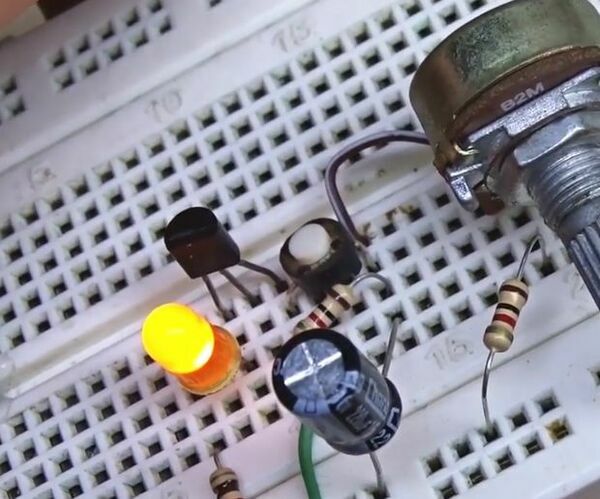
Time Retardant Circuit
"Hey friends, This is just a quick project Time retardant circuit without 555, in this instructable I will show how to make it step by step. Let's Get Started! " [...]
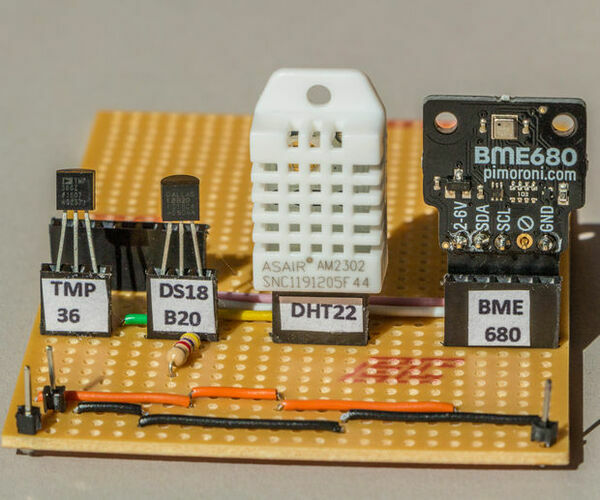
Testing Temperature Sensors - Which One for Me?
"One of the first sensors that newcomers to physical computing want to try out is something to measure temperature. Four of the most popular sensors are the TMP36, which has analogue output and needs an analogue to digital converter, the DS18B20, which uses one-wire connectivity, the DHT22, or the slightly cheaper DHT11, which just needs a digital pin, but also provides an humidity reading, and lastly the BME680 which uses I2C (with SPI as well on some breakout boards) and gives temperature, humidity, gas (VOC) and atmospheric pressure but costs a bit more. I want to see how accurate they are, and discover any advantages or disadvantages. I already own an accurate mercury thermometer, left over from the colour photographic printing back in the days of chemical processing, to compare them against. (Never throw anything out - you will need it later!) I'm going to use CircuitPython and an Adafruit Itsybitsy M4 development board for these tests." [...]
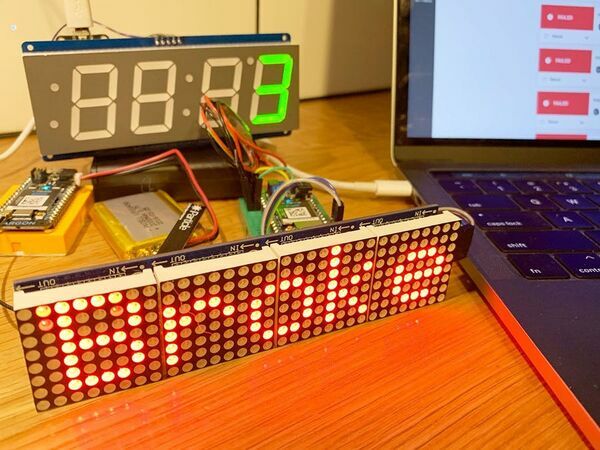
Broken CircleCI Builds and Particle Mesh
"Display broken CircleCI builds with a Particle Mesh IoT network. Instead of a scrolling marquee displaying unique messages, I wanted to only receive notifications when a continuous integration platform failed a build. Things that would be helpful in this notification would be, what branch failed and who was the user. CircleCI is a great continuous integration platform that I use a lot for personal projects, however I sure this approach (or similar) will work with most. The CircleCI config.yml allows you to call a command on "Build Failed". This is great, because we can cURL a POST request to an API passing it our CIRCLE_BRANCH and CIRCLE_USERNAME." [...]
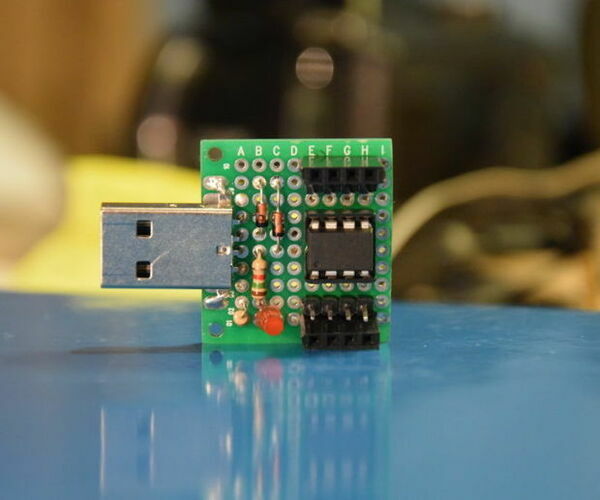
Home Made Digispark
"Digispark is an ATtiny85 based microcontroller development board come with USB interface. Coding is similar to Arduino, and it use the familiar Arduino IDE for development. My digispark will be powered by USB only. Digispark is fully compatible with arduino. Specification: -Support for the Arduino IDE 1.0+ (OSX/Win/Linux) -Power via USB -6 I/O Pins (2 are used for USB) -6K Flash Memory after upload bootloader -I2C and SPI -PWM on 3 pins (more possible with Software PWM) -ADC on 4 pins" [...]
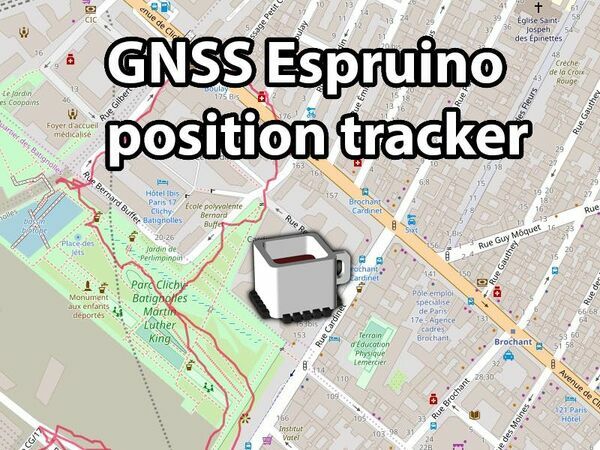
GNSS - Track Your Position with Espruino
"Track your position and view your full route on a map! My initial goal was to know where my cat could be when we do not see him all day long. I wanted a module as small and light as possible, and a battery that takes at least 12 hours or more. The simplest construction is to save a position (lat-long) every [n] -second on an SD card module, and when the beast comes home because he have to eat, get the list of points of the SD card and display its course on a map !. Well, the module is still a bit too big to put around the neck of Kenzou the cat, but it is a simple project and fun to achieve with my great friend Espruino, this little wonder that allows to code JavaScript on a microcontroller so easily. ; -)" [...]
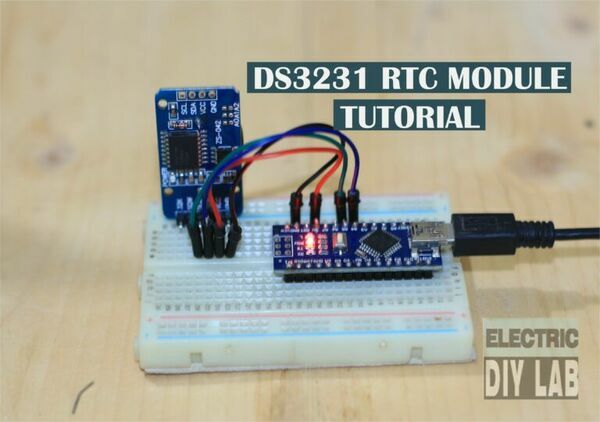
Arduino Real time clock (RTC) DS3231 Module Tutorial
"In this article we will learn what is RTC DS3231 Module is, how to use it with arduino. RTC stands for Real Time Clock module as name suggest this module deals with time. This module work as clock for arduino, but now question is why we need external clock when there is already inbuilt clock in Arduino. So the inbuilt clock system of arduino is reset when we power off or reset the arduino so it will lost the track of time and starts from zero. But in case of RTC DS3231 timer does not rest either we turn off its suppy or reset the arduino, because RTC DS3231 is powered with a coin battery CR2030 DS3231 RTC MODULE DS3231 RTC module is low cost highly accurate time clock, this modules works on I2C communication protocol This module can count seconds, minutes, hours, day, month & year with compensation of leap year this module can works on 3.3 or 5V this make very easy to use with verity of platform. the battery can last upto 1 year." [...]
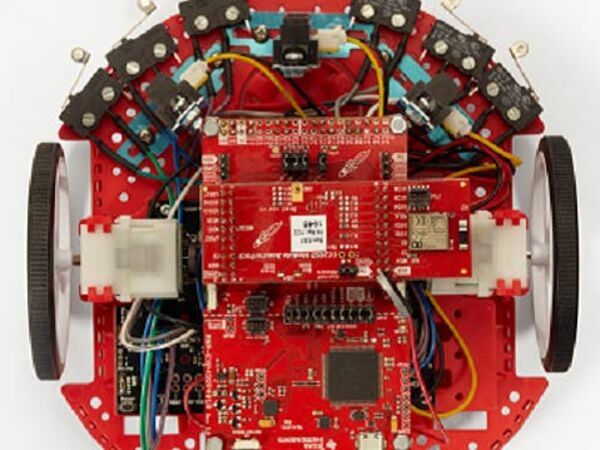
How to Build a Motion Control Robot
"Control the motion of robot by your mobile, Using TI RSLK kit, MSP432 microcontroller and POLOLU board for power distributon. We will be making a robot that will accept navigation command from a custommade app and follow it accordingly. It is programmed in such a way that it will follow certain commands like motion our phone. For this, we will be needing TI-RSLK. It contains MSP432 microcontroller, Pololu board, chassis, tires, and motors. MSP432 is a combination of MSP430 and Arm CORTEX microprocessor, the power supply of 7800mAh is given by Pololu board." [...]
That's all Folks!



